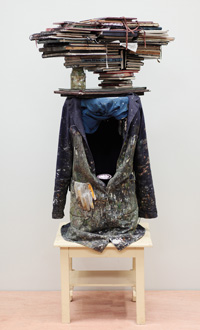The absent mind

Absent: mind & matter (meeting with self) 1984-2011
Mixed media installation and video projection. 164 x 80 x 50 cm.
Artist text published in: Apertures & Anxieties: Artists celebrate 300 years of Trinity’s School of Medicine.
Curated by Patrick T Murphy at the RHA, Dublin 2011
The invitation to participate in this project came in 2009, while I was trying to resolve paintings that I had worked on intermittently since 2004. They were internally focused attempts to give visual form to mental activity; ruminative and exploratory, but the kind of work I never quite intended to exhibit. I normally look outwards, painting portraits, landscape and objects, but all the time aware that the real work happens during fleeting moments of pure attention and connectedness, between the world beyond my physical person and consciousness within.
I have had a long personal interest in brain science that was heightened by family experiences of Alzheimer's disease and other cognitive problems. I read broadly about the radical shifts taking place in Neuroscience, how “Neuroplasticity” and Quantum physics are slowly prizing open the last century’s all embracing stranglehold of deterministic scientific materialism. Advances in functional brain imaging are now enabling neuroscientists and neuroanatomists to study and record the effects of mind on matter. While there is still, in the scientific realm, a huge gulf of opinion on the relationship between the physical brain and the nature of mind; consciousness is no longer the ‘off limits’ subject it once was. The opportunity to explore these matters further in my work, with scientists at the forefront of this research, was irresistible.
The winter before, I had been experimenting alone with a whacky practice involving visualisations of the Amygdala (a part of the brain strongly associated with conditioning and emotional learning ) during daily walks by the sea, and painting emergent imagery. I was trying to observe and to derail psychological patterns in myself; the ‘hijacked’ primal responses and repetitive neural pathways that are the ruts of unattended thought. I was curious to see if ‘attention’ and ‘intention’ could switch thought processes and access the higher level thinking and expanded awareness that are associated with the frontal cortex.
My first port of call in Trinity was the Anatomy Department to ground myself again in physical reality. I had asked if I could paint a human brain. In the early 1990s, working from cadavers had radically altered my approach to painting, but this was the first time I had seen, held or painted someone’s brain. The staff graciously facilitated this encounter and left me quietly to my work. It was a difficult week, facing an indescribable sense of ‘anti-matter’ in the preserved material that once had been so full of a person’s consciousness. I was surprised by the weight of the subject and the lightness of the anatomy paintings I made in response. Despite my total absorption with the physicality of the brain, I returned to the internal works, until that energy was spent. The real subject eluding me was the absent mind.
I have always kept notebooks, and I am simultaneously attached to, and overwhelmed by their record. With contradictory impulses towards privacy and exposure, I had often considered their destruction. As I began to look deeper into Neuroscience and Psychology, I reflected on the ‘elusive mind’, and decided to take mine into my own hands. I spent months looking back through the notebooks, dating back to 1984, reading and committing those 28 years to fragile memory and forgetfulness, then sealing up each page with archival adhesive. Initially a disturbing and conflicted process, it gave way to a huge sense of relief and liberation as I slowly began to construct matter from my mind. The result, a sculpture of sorts, is the closest I could come to a very fugitive subject.
Nick Miller, 2011
Acknowledgments: Sincere thanks to all those in the School of medicine and Institute of Neuroscience who unreservedly welcomed and indulged me in their workplace: To Philomena McAteer and Siobhan Ward, who run the Anatomy Department with remarkable tact and sensitivity and to Paul Glacken, Professor of Anatomy, who cast a clear eye on my studies: To Professor Shane O’Mara, Director of the Institute who introduced me to the seminal work of Donald Hebb and the unsurpassable beautiful drawings of the Spanish Neuroanatomist and artist Santiago Ramón y Cajal: To Ian Robertson, Professor of Psychology, for the fascinating discussions and introduction to his team’s research . His work on the role of ‘attention’ in the brain, I had seen frequently referenced in the new literature, and whose books “The Mind’s eye” and “Mind Sculpture” I read with great interest, eagerly awaiting the next on the affect of ‘power’ on the physical brain: To Simone Salmone for showing me around the lab and running me through some research & tests: And to Thomas Frodl and Joseph Sojo for my scan, in search of the artist’s missing brain!
Download PDF